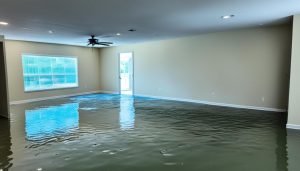The Centers for Disease Control and Prevention (CDC) says buildings should be cleaned within 24 to 48 hours after a flood to stop mold. But, it takes at least 12 hours just to start drying a water-damaged house. This shows how urgent and complex fixing flood damage is. Homeowners must act fast to protect their health and property.
When a flood happens, quick action is key. Removing water and using dehumidifiers and fans right away can help avoid mold and damage. FEMA says homeowners have up to 60 days to file a flood insurance claim. This means documenting all damage well before starting to clean is vital. The drying time can vary from days to weeks, depending on several factors.
With the right knowledge and a proactive mindset, homeowners can handle the stress of drying out a water-damaged house. The time it takes for a flooded house to dry out can change a lot. It depends on the actions taken right after the flood.
Key Takeaways
- The CDC urges cleaning buildings within 24 to 48 hours post-flood to prevent mold growth.
- It generally takes at least 12 hours to commence the drying process of a flooded house.
- Homeowners have up to 60 days to submit a Proof of Loss to flood insurance, per FEMA guidelines.
- Immediate debris removal is essential to lessen further water damage and mold proliferation.
- Documenting damage with photos or videos can aid in filing insurance claims effectively.
- It can take days to multiple weeks for walls to completely dry after a flood.
- Weather conditions, wall moisture levels, and employed drying methods significantly affect the drying timeline.
Factors Affecting the Drying Time of a Flooded House
The time it takes to dry a flooded house depends on several factors. The source and amount of water are key. Clean water is easier to remove than greywater or blackwater, which can slow down the process.
The type of materials affected also matters. Experts say it can take a month for every inch of wall thickness to dry. This is before you can safely move back in.
Weather conditions, like humidity and temperature, also play a big role. High humidity slows down drying, while good conditions speed it up. Using dehumidifiers and fans helps a lot, making it faster to dry areas like crawlspaces and basements.
It’s important to start drying right away. Mold can grow in just 24-48 hours. Removing wet items within 24 hours can help save them from mold damage.
- Dehumidifiers help speed up drying and prevent moisture from coming back onto surfaces.
Different drying methods affect how long it takes to dry a house. Positive pressure drying is faster but safer for clean water. Using dehumidifiers, pressure dryers, fans, and heaters together is the best way to remove moisture quickly.
Professional cleaning is often needed to make sure the house is safe and sound. Water damage can weaken materials like drywall and flooring.
In severe cases, drying a house can take days to weeks. Over half of property owners in United States have dealt with water damage. Installing membrane systems can help dry walls faster, allowing quicker return to the property. Keeping humidity levels below 60% is key to stopping mold growth.
How long does it take for a flooded house to dry out?
The time it takes for a flooded home to dry out depends on several factors. These include the size of the affected area and the drying methods used. For a single room, it usually takes about 72 hours to dry completely. But, larger areas or entire houses take longer.
Professionals use high-powered fans to start the drying process. These fans can show results in just a few hours for minor water damage. Dehumidifiers also play a key role by reducing air moisture levels, speeding up drying.
Opening windows and using fans to improve airflow is another good strategy. This method can remove gallons of water each day, speeding up drying. But, if the outside air is humid, dehumidifiers are more effective.
For serious flooding, professionals use large submersible pumps to quickly remove water. Combining these pumps with air movement can greatly improve drying times. Heating the house to around 80 degrees Fahrenheit also helps dry it faster. But, you might need to adjust the air conditioning to manage moisture.
Quickly addressing damaged items can prevent long-term damage. For example, water-damaged items should be handled within 48 hours for the best chance of recovery. Insulation should be removed up to 12-18 inches above the water line for effective drying. Wooden structures need to have moisture content below 15% before they can be rebuilt.
Using desiccants like silica gel in enclosed spaces and freeze-drying techniques for important documents can prevent damage. The sooner moisture is managed, the better chance of saving more items and keeping the home’s structure intact. Acting quickly is important because mildew and mold can grow in just 24 to 48 hours under the right conditions.
Conclusion
Drying out a water-damaged house is a complex task. It affects how quickly a house can recover and its long-term condition. Factors like humidity, temperature, and the amount of water play big roles. Under the best conditions, a single room can dry in about 72 hours. But bigger and more serious cases might take weeks.
Acting fast is key when dealing with water damage. Quick action in the first 24 to 48 hours helps stop mold and keeps the structure sound. Experts use powerful tools like air movers, dehumidifiers, and pumps to speed up drying. These tools work much better than regular fans and dehumidifiers.
Water damage happens to nearly 14,000 people in the U.S. every day. Knowing how to dry out a water-damaged house is very important. Water damage claims often cost over $10,000, showing the financial risk of slow or bad drying. By knowing the right steps and using the right tools, homeowners can protect their homes and get back to normal quickly.
If you have a flooded house, basement or business in the Tampa Bay area contact Expert Water Removal for help dealing with the flood and getting flood damage restoration as soon as possible.








